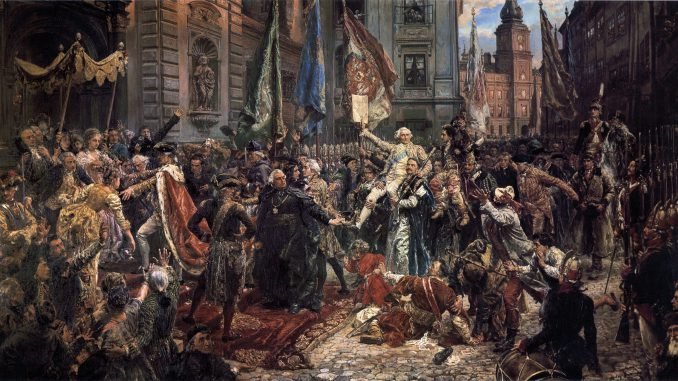
The Polish-Lithuanian state drafted the constitution during a tumultuous period in its history in an attempt to stop its demise. It was the first written constitution in Europe and the second one in the world, after the one created in the United States in 1787.
The Polish-Lithuanian constitution was drafted by the Four-Year Sejm, or the parliament of nobles. It instituted a hereditary monarchy, centralized the state’s government and envisaged to create two houses of parliament: the House of Representatives and the House of Senators.
The constitution moved the republic away from aristocratic rule closer to popular sovereignty, extending political rights to include not only the nobility, but also the bourgeoisie and grant some rights to the peasantry. The constitution also preserved tolerance that different confessions had enjoyed in the Polish-Lithuanian Commonwealth for centuries.
Unfortunately, the constitutional reform could not prevent the decline of the state, which was partly to blame on in-fighting among groups of the nobility. In 1795, the Polish-Lithuanian state ceased to exist with its lands partitioned by Russia, Prussia and Austria.
Still, Poland celebrates May 3 as the Constitution Day and the occasion was marked in Lithuania on Monday.
“No nation, no community can exist without a collective memory, without a common past and values uniting that community,” said Deputy Speaker of the Polish Senate Marija Koc at the event in Vilnius. “The May 3 Constitution is one of the most important moments in the collective memory of the Polish and Lithuanian nations. It was a great achievement that united the two nations in one state, the Republic of Both Nations.”
“Adopting the constitution and strengthening the state was more important than continuing the in-fighting,” said Lithuanian Parliament Speaker Loreta Graužinienė.
Lithuanian historian Algimantas Kasparavičius says that the May 3 Constitution is a monument to Polish-Lithuanian unity and and important episode aligning the two nations with the European cultural, historical and legal identity.
“The Constitution is created during the years of the French Revolution, when France adopts the famous Declaration of the Rights of Man and of the Citizen. And so this society in Central-Eastern Europe, the nobility, is trying to modernize their state as well,” said Kasparavičius, a research fellow at the Institute of History. “Towns and villages are granted self-rule. The rights of the bourgeoisie get extended. There is essentially a limited division of powers with a legislative, executive and judicial branches of government.”
The resolute attempt of reform in the Polish-Lithuanian Commonwealth also mobilized opposition from aristocrats and the Russian Empress Catherine II. The May 3 Constitution remained in force for merely 14 months.

Be the first to comment